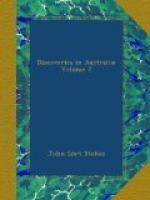(In latitude 30 degrees 25 minutes South and 65 miles from the land, soundings were got from the Beagle, with 185 fathoms of line, upon a coral bottom. Between Swan River and Houtman’s Abrolhos, soundings may be had at a greater distance from the land, than off any other part of the west coast.)
The North-West gales are of longer duration, in the latitude of Swan River, and south of that, than they are to the northward; they do not appear to be entirely confined to the winter months, as I am told that a very heavy one was experienced at Swan River, early in March, 1832, and on the 13th December, 1839, the Beagle experienced a strong breeze from the northward, while at anchor in Gage Road, in consequence of which, it was considered necessary to let go an extra anchor.
As it may be satisfactory to know more particularly the progress of these gales, and the effect they have upon the barometer and sympiesometer, I give the details of two that were experienced in H.M.S. Beagle, one at Swan River, in the beginning of June 1838, the other at Houtman’s Abrolhos, in the beginning of May 1840; they may be taken as fair criterions of the strength and duration of these gales, the latter having been experienced, probably, within 5 degrees of their northern limit, and the former near the southern extreme of the west coast.
As our barometer had been broken in March 1838, the register of a sympiesometer will be given in describing the gale of June in that year; but as this instrument had been found (by comparison with the barometer) to act exceedingly well, it will be sufficient for our purpose; the GENERAL use of a marine barometer being merely that of a weather glass, for which purpose a sympiesometer is equally good, and more sensitive.
For the gale of 1840, the register of a barometer is shown, which, although 0.2 too low, will serve to show the effect upon the mercury.
At Swan River, on the 24th of May, 1838, the wind was strong and squally from North-East by North; sympiesometer standing at 30.74. During the day the oil commenced to fall, and continued falling slowly until the 30th, when it was 30.16; during the greater part of this interval, the winds were light, generally from some eastern point in the morning, and going round the compass, by north and west, during the day; the nights were mostly calm, a heavy bank of clouds was collecting between North-North-East and South-West and the whole western horizon had a gloomy appearance. On the evening of the 30th, the water had risen considerably at the anchorage, and the stream ran to the southward; a fresh breeze also set in from North-East and gradually veered to the northward, as it increased in strength. On the 31st it blew hard all day, between North-North-East and North-North-West, with dark squally weather, much lightning in South-West and heavy rain, that continued all night. On June the 1st, the gale was at its height, and at 8 A.M. (the sympiesometer having fallen to 29.93) was blowing a hard gale, with heavy squalls and rain, from North-West; towards noon the wind veered to west, but still blew very hard; the sympiesometer now began to rise, and in the evening the wind was West-South-West and had moderated considerably, the weather was also clearer, although heavy clouds still hung on the western horizon.




